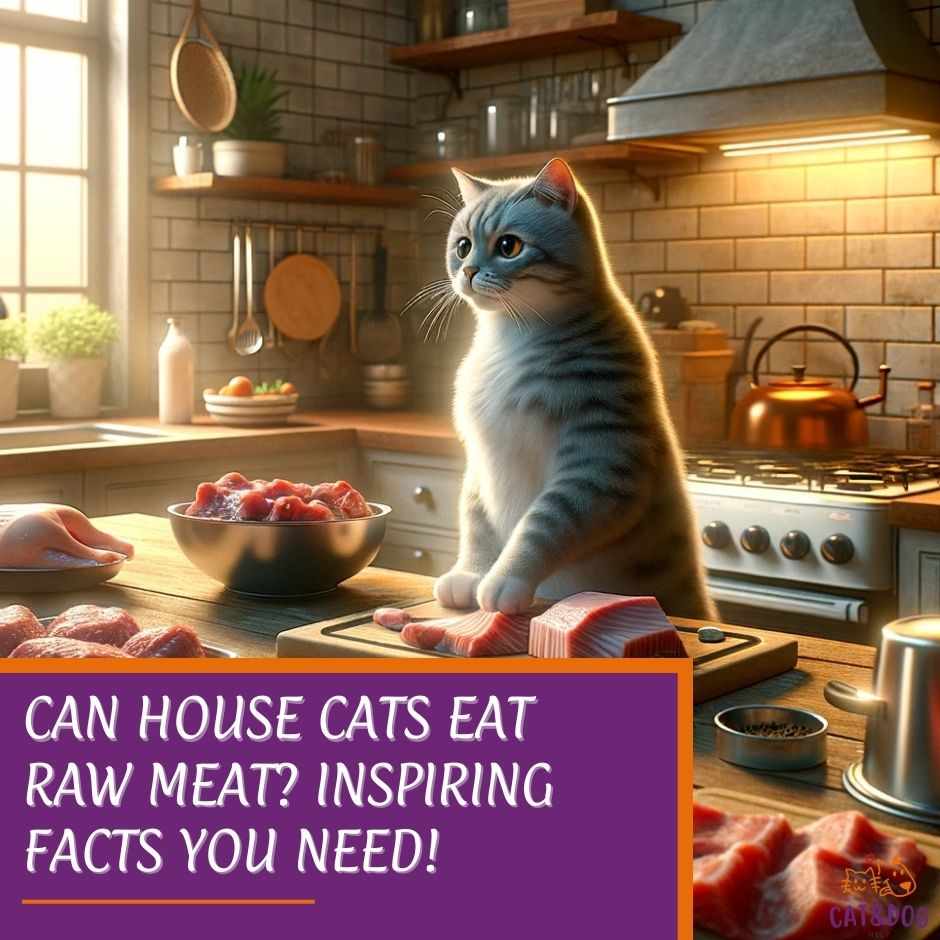Can house cats eat raw meat?
Ever noticed your feline friend eyeing your steak with the intensity of a furry little food critic?
Well, turns out, offering raw meat to house cats isn’t just a hypothetical scenario up for cute social media posts; it’s a real diet trend that’s clawing its way into the hearts of many cat owners.
The idea itself isn’t anything new—after all, cats in the wild have come a long way since their ancestors, and some pet owners are now choosing to feed their pets a raw food diet, with the help of pet food subscription companies like Bella & Duke, as well.
But house cats? That’s a different ball of yarn. Implementing a raw meat diet in the comfortable confines of your home comes with its own set of steak-sized considerations. (1)
Firstly, it’s a hearty nod to their natural carnivorous habits, with potential perks like a sleeker coat and more energy.
We’ll also cover some of the most toxic foods that can be easily confused for cat treats, such as grapes, tulips, etc..
Key Takeaways
- Raw meat diets for cats can mimic their natural eating habits and may offer health benefits.
- Such diets come with risks, including potential pathogens and nutritional imbalances.
- Consultation with a veterinarian is essential when considering a raw meat diet for your cat.
Can House Cats Eat Raw Meat: Nutritional Analysis
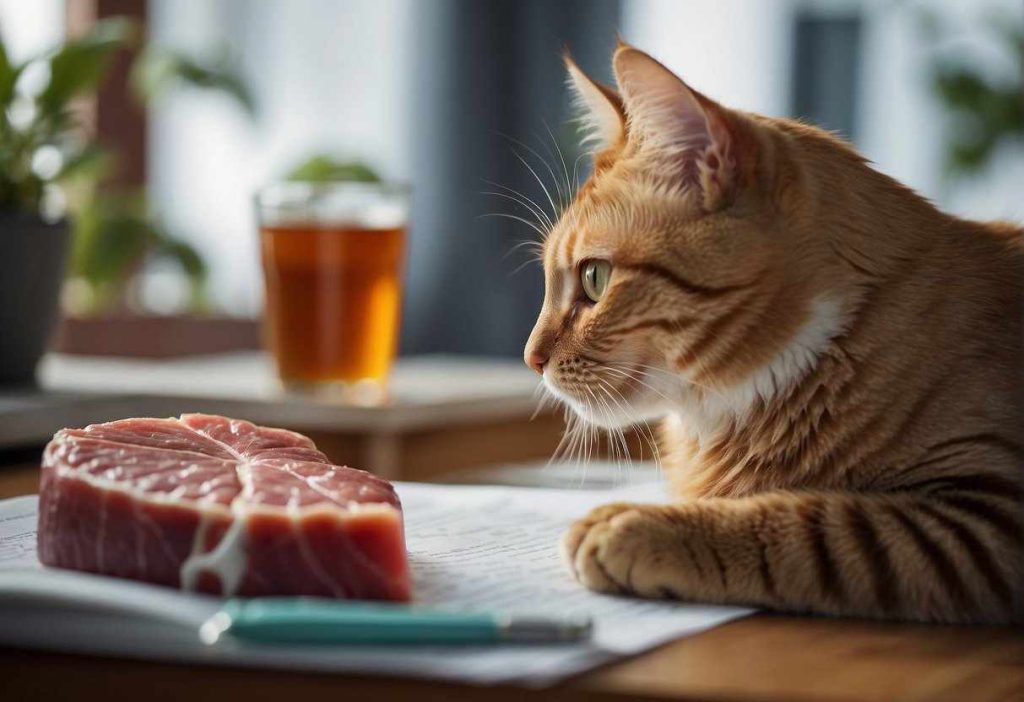
Ever wondered why your feline friend pounces at the chance to nibble on raw meat? It’s because, as obligate carnivores, cats are hardwired to crave animal-based proteins.
Supporters of raw diets for cats usually mention that such meal options allow the cat to consume the food felines are biologically prepared to digest.
After all, no one is cooking the rodent a wild cat just caught for dinner. Raw meat diets can provide a range of nutrients that are essential for your cat’s health, meeting the specific needs of your pet, just like a wild cat.
However, it’s important to consider that our domesticated felines have come a long way since their ancestors, and the life expectancy of our pets is greater than that of wild cats.
Incorporating raw meat into your cat’s diet can provide essential nutrients for their health, such as protein and taurine, which help improve vision, keep their heart strong, and bolster their immune system.
Let’s cut through the fur to see if it’s all purrs and no growls when incorporating a little raw meat into your cat’s diet.
What’s on the menu?
Typically, raw meat diets for cats include muscle meat, organs, and sometimes even bones. Here’s a tidbit for you: These meals are teeming with high-quality protein, fatty acids, vitamins, and minerals. (2)
- High-Quality Protein: Vital for growth and maintaining muscle mass. (3)
- Fatty Acids: Support a shiny coat and healthy skin. (4)
- Taurine: An essential amino acid found abundantly in raw meat.
- Vitamins & Minerals: Including A, B vitamins, zinc, and iron.
Balancing Act:
Are you about to switch your cat to a gourmet raw meat diet? Hold on to your hats! Balance is key. Feeding a complete diet of purely muscle meat might lead to deficiencies in calcium and other nutrients.
You wouldn’t want your whiskered companion to miss out, right?
A well-balanced raw diet should also incorporate complementary food, in line with the manufacturer’s recommendations, to ensure your cat receives all the necessary nutrients according to the manufacturer’s recommendations.
It is important to follow the manufacturer’s recommendations for a balanced and healthy diet for your cat, as they have specific guidelines for the best nutrition for your pet.
- Organs: Like liver and kidneys for a vitamin and mineral boost. (5)
- Bones: Usually ground, they’re nature’s way of providing calcium.
Remember, it’s not all about the ‘what’, but also the ‘how.’
Considering the prep, you’ll want to ensure the raw meat is fresh and handled safely to avoid bacteria like Salmonella or E. coli, which love to crash the party uninvited. Okay, let’s paws for a moment. (6)
Here’s a pro tip: If you’re unsure about nutritional balance or safety, consulting with a pet nutritionist or vet for advice or considering commercially prepared raw diets could be your lifesaver.
They’re specifically crafted with your kitty’s nutrition in mind and are typically subjected to rigorous safety standards from reliable sources, making them a better option for your cat’s health and a more balanced diet with appropriate quantities of nutrients and properties of ingredients.
However, it is important to note that feeding a raw diet for cats is a controversial topic and there can be genuine health risks to you and your pet, contributing to both sides of the debate.
If you decide to try raw feeding, it is always best to discuss this with your vet first.
They can advise on responsible raw-feeding, making sure your cat receives a suitably balanced diet with appropriate quantities of nutrients, including their nutritional requirements, and highlight some of the health and hygiene concerns that need addressing.
While considering raw diets, it’s also beneficial to explore economical cat food choices for your pet, ensuring they receive a balanced diet without compromising on quality or nutritional value
Remember, safety first when it comes to incorporating raw cat food diets into your cat’s diet.
Alongside the raw meat options, incorporating a fiber-rich diet is crucial for constipated cats to ensure their digestive health is maintained.
There—you’ve got the meat of it! By keeping these nuggets of info in mind, you can help ensure your cat’s raw diet is as purr-fectly nutritious as it is delicious.
Types of Raw Meat Suitable for Cats
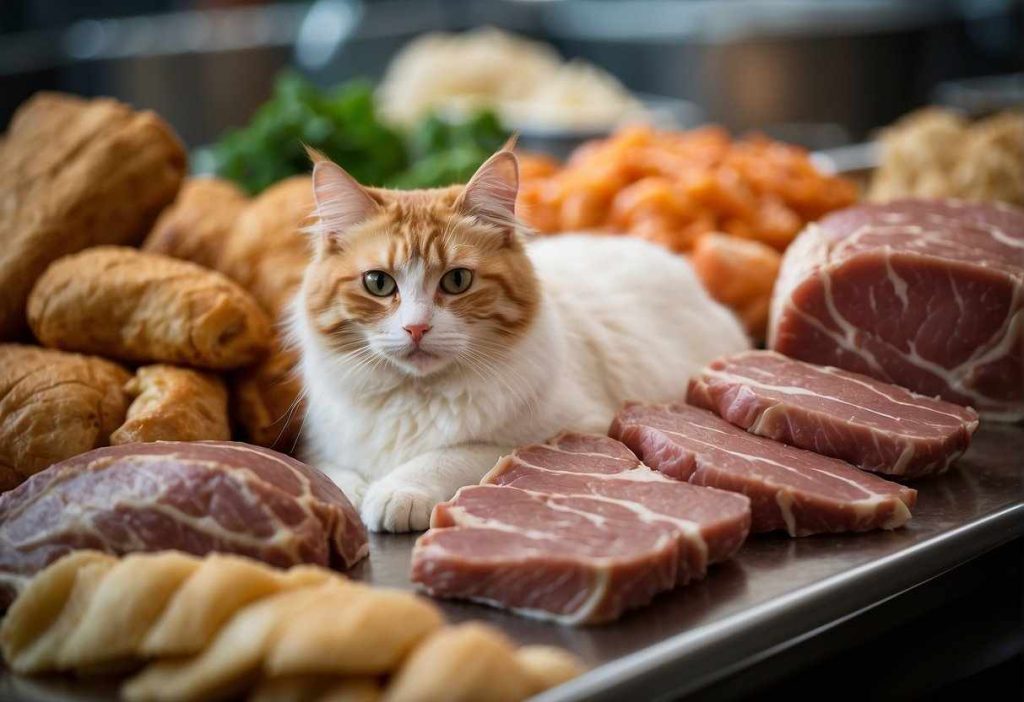
Ever wondered what types of raw meat you can safely offer to your feline friend? Cats are obligate carnivores, which means that they thrive on a diet rich in animal-based protein.
Let’s chat about the kinds of raw meat, including staple food, raw offal, and other uncooked ingredients that are not only safe but can contribute positively to your cat’s diet for pet parents looking to provide a more natural and nutritious diet for their furry companions. (7)
However, it’s important to note that while raw meat can be a beneficial addition to a cat’s diet, it should not be used as a staple food and should only be given as an occasional treat.
Firstly, chicken is a great option—it’s lean, packed with protein, and usually well-tolerated by most cats. Make sure you’re offering boneless cuts to prevent any choking hazard.
How about turkey? It’s another poultry product that’s high on the list and similar to chicken in benefits and precautions.
Moving on to red meats, beef is a strong contender. Opt for lean cuts like steak pieces rather than fattier ground beef to avoid any unnecessary weight gain.
And here’s a fun fact: small amounts of liver can provide your cat with a nutrient boost, but moderation is key to preventing vitamin A toxicity.
Now, let’s not forget about fish. It’s a bit of a gray area though.
A bit of fish can be beneficial, but it’s best to limit it due to potential heavy metals and thiaminase, an enzyme that can break down vitamin B1, leading to deficiencies.
Here’s a quick serving suggestion:
- Chicken/Turkey: A few small, boneless pieces a few times a week.
- Beef: Small, lean cuts equally portioned out through the week.
- Liver: A small piece once a week at most.
- Fish: Occasionally and in limited amounts.
Remember, when you feed your cat raw meat, it’s crucial to ensure it’s fresh and handled hygienically to minimize the risk of bacterial contamination like salmonella or E. coli.
Variety is the spice of life but also an excellent way to ensure a balanced diet for your kitty.
Keep portions appropriate for your cat’s size and caloric needs, and always consult with your vet if you’re unsure about providing a suitably balanced diet for your cat.
However, be cautious when offering small bone pieces as they can cause internal damage if not fed properly. Happy feeding!
Veterinary Insights and Medical Advice
Did you know that many vets have quite a lot to say about your cat’s diet?
Some say that a raw meat diet can harness your cat’s inner lion, while others wave a red flag, warning about potential risks. Let’s peel back the layers here!
Pros of a Raw Meat Diet:
- Mimics Natural Diet: Your cat’s ancestors didn’t have the luxury of kibble, right? They’re built to handle raw meat.
- Improved Digestion: Those tiny carnivorous tums are designed to digest raw meat.
- Potential Health Perks? There’s talk about a raw diet boosting kitty’s immunity. Imagine fewer vet visits!
Now for the Cons:
- Parasite Risk: Ever heard of Toxoplasmosis gondii? It’s a pesky parasite that can crash the raw meat party.
- Bacterial Concerns: Vets are sounding alarms about bacteria like Salmonella, which can be harmful to both your cat and you.
Keeping Watch:
- Good signs: Are they playing more? Giving the furniture a workout with those claws? Excellent!
- Warning signals: Lack of appetite or changes in the litter box routine could signal trouble.
Remember, this isn’t a mouse-and-cheese game. It’s about your feline’s health. Some studies, like one that noted an increase in white blood cells, suggest benefits to a raw diet. But there’s more to study.
The Verdict? Sit down with your vet and chew on the idea together. Every whisker twitch and tail flick from your cat is a tale of their health, so monitor closely if you decide to go raw.
Keep it clean, keep it safe, and may the purrs be ever in your favor!
Implementing a Raw Diet for Your Cat
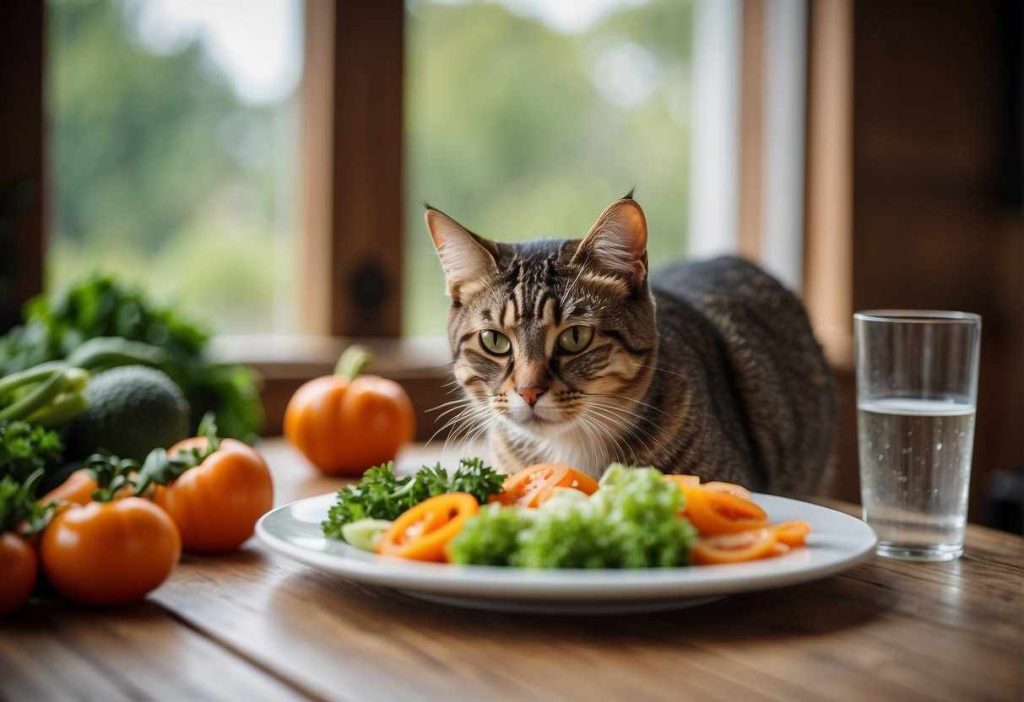
Transitioning Steps
Transitioning your cat to a raw diet should be a gradual process, tailored especially to their life stage.
Here’s how you can kickstart this healthy lifestyle:
- Puppies and Kittens
- Start with easily digestible, high-quality raw meat.
- Introduce raw food gradually over a week, mixing with their current diet.
- Adult Cats
- Switch from free-feeding dry food to scheduled meal times.
- Over 7-10 days, mix increasing amounts of raw food with their usual diet.
- Senior Cats
- Consult a vet for a tailored plan considering age and health.
- Transition slowly and monitor for any health changes.
Homemade vs. Commercial Raw Diets
When choosing between homemade and commercial raw diets, consider the following:
| Homemade Raw Diet | Commercial Raw Diet | |
| Pros | ✓ Tailor to cat’s preference | ✓ Convenient and time-saving |
| ✓ Control over ingredients | ✓ Often complete and balanced | |
| Cons | ✗ Time-consuming to prepare | ✗ Can be expensive |
| ✗ Risk of nutritional deficiencies | ✗ Quality varies between brands |
Maintaining Balance
Hey there, pet parents! Remember, balance is key. Whether you create your cat’s menu from scratch or go with a pre-made product, you’ll want to make sure their meals are nutritionally complete.
Aim for meats rich in taurine, like heart and liver, and consider adding a supplement designed for raw feeding.
It’s important to maintain a balance of both wet and dry food in your cat’s diet, as well as avoid feeding them puppy or dog food which can be deficient in taurine.The nutritional needs of dogs and cats are different, therefore, the nutritional content of their food is also different.
Just like with humans, variety is important in a cat’s diet, and incorporating raw meat can be beneficial as long as it is done safely and in moderation.
Go on, take the plunge! By serving up a balanced raw diet, you’re on your way to nurturing a healthier, happier kitty.
Just don’t forget to chat with your vet–they’re like the sous chefs in your cat’s culinary journey.
Practical Guidelines for Raw Feeding
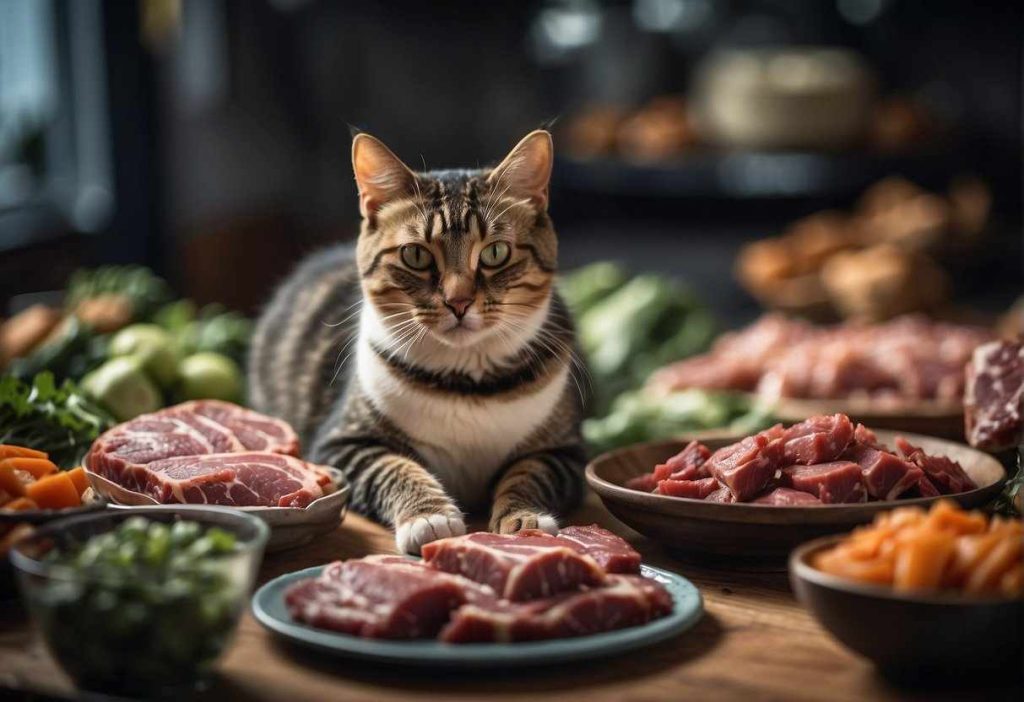
Embarking on a raw-feeding journey with your furry friend? That’s paw-some! Let’s ensure your cat gets all the benefits without any hiccups.
Here’s the scoop on how you can manage a raw diet – safely and effectively.
Portion Control & Feeding Frequency: You’re likely wondering, “How much and how often?” A general rule is to feed adult cats about 2-3% of their body weight daily, split into two meals.
Kittens, though, are growing machines! They need up to 5% of their body weight and several meals a day.
Keep an eye on your cat’s weight and condition; active mousers may need more, while lap loungers might need less.
Adjusting the Diet: Every cat is unique, like snowflakes! Monitor your pet’s health and adjust the diet as needed.
If your kitty has a special condition or less of a spring in their step, consulting a vet for a tailored plan is a smart move.
Storing & Handling Raw Meat:
- Don’t play hot potato with meat – keep that raw protein refrigerated or frozen.
- Hygiene is king: Always wash your hands after handling raw food.
- Kitchen rule: Clean all surfaces and utensils after prepping your cat’s meal.
Concerned about bacterial contamination or parasites? High-quality commercial raw diets undergo processes to reduce these risks.
But, don’t let your guard down – keep that meat at safe temperatures and use it before the expiration date.
Here’s a quick reference table:
| Activity Level | Adult Portion | Kitten Portion |
| Low | 2% body wt. | 4% body wt. |
| Moderate | 2.5% body wt. | 4.5% body wt. |
| High | 3% body wt. | 5% body wt. |
Feeding raw can be paws-itively enriching for your cat – just be sure to follow these guidelines for a happy, healthy kitty. And remember, if in doubt, a chat with your vet is worth its weight in catnip!
Addressing Common Concerns and Misconceptions
Cats are obligate carnivores, meaning their bodies are fine-tuned to munch on meat.
Myth: Raw meat is swarming with harmful bacteria that will make your cat sick.
Fact: Sure, all meat has bacteria, but a cat’s short digestive tract quickly processes meat, reducing the risk of sickness.
However, it’s important to handle meat with care to minimize exposure to nasties like salmonella and E. coli, as there are potential safety risks for both cats and humans when feeding a raw diet, including the risk of contamination from parasites and bacteria living in raw ground meat such as raw pork.
Additionally, feeding raw ground meat, such as raw beef or pork, to cats can pose a health risk due to the presence of bacteria such as Campylobacter, Clostridium difficile, C. perfringens, C. botulinum, E. coli, Yersinia enterocolitica, and enterotoxigenic Staphylococcus aureus.
It is important to be aware of these risks and take proper precautions when feeding raw ground meat, including raw pork, to cats.
We can minimize the risk of contamination by using a suitable commercial diet, disinfecting all surfaces that have come in contact with the food, and thoroughly washing hands or even wearing gloves when handling it.
Pregnant or immunocompromised people should be particularly cautious, as they are at greater risk.
However, it is important to note that with proper handling and preparation, the risk of contamination and risk of food poisoning, including the risk of food poisoning from raw meat, can be minimized and the potential benefits of a raw diet for cats can be realized.
Myth: Raw food equals a balanced diet, right? Fact: Not so fast. Cats require specific nutrients that raw meat alone might not provide. It takes a well-researched plan or a commercially prepared raw diet to hit all those nutritional notes.
- Protein: High-quality and for muscle maintenance
- Fat: Around 20% for energy (but no chunky monkeys here!)
- Moisture: Raw diets help hydration, which is essential for preventing urinary tract issues
Concerned about the environment? A raw diet might be more about what your cat isn’t eating—like that kibble processed in factories emitting carbon by the truckload.
Remember, you’re aiming for a happy, healthy kitty and a happier planet. It’s not just about today’s dinner; It’s about those nine lives in the long run.
So, if you’re considering raw, chat with your vet, balance that diet, and serve up a slice of the wild safely!
Quick Recap
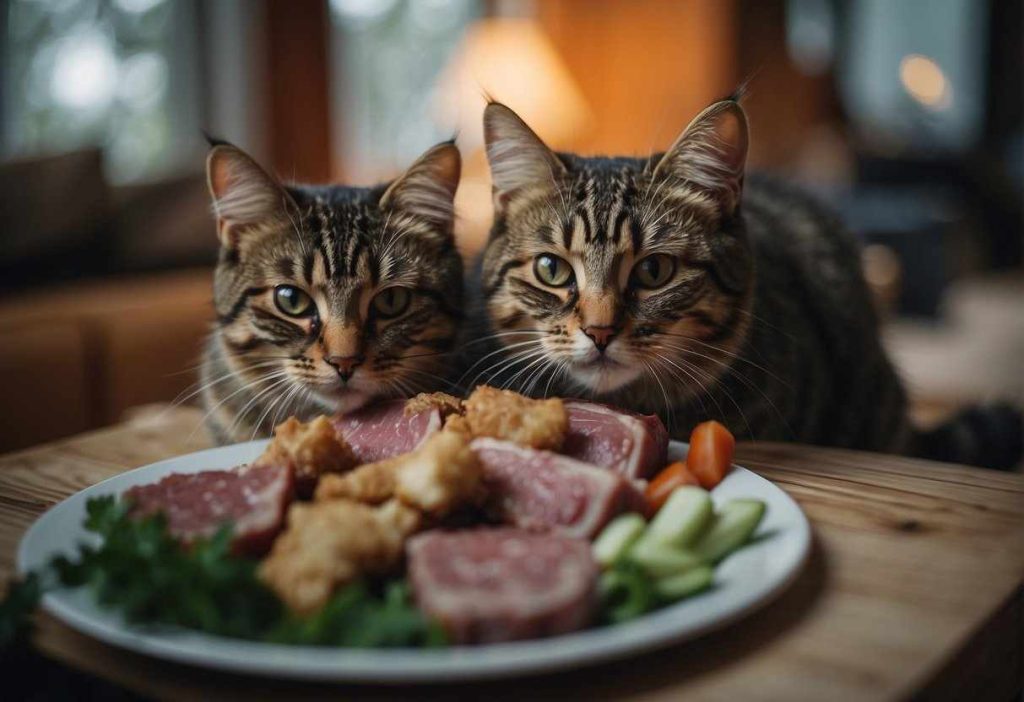
- Pros of Raw Meat:
- Improved Digestion: A raw diet often leads to a leaner body and may avoid some digestive issues.
- Healthier Coat: Expect a shinier coat due to the natural fats in raw meat.
- Cons:
- Pathogens: Beware of bacteria such as salmonella and E. coli, which can lead to illness.
- Nutritional Balance: A diet with only raw meat might lack the essential nutrients cats require.
Feeding your cat raw meat isn’t a simple yes or no question. If you’re considering it, do your homework! Here’s what to keep in mind:
- Safety First: Any raw meat should be fresh and handled with care to minimize bacterial exposure.
- Balance is Key: Ensure the diet is well-rounded, covering all nutritional bases. Sometimes, supplements might be necessary.
Wondering about portion sizes and meal prep? Consult your vet — they’ll give tailor-made advice for your kitty’s needs.
Remember, a switch to raw feeding is a commitment. Stay informed, always prioritize safety, and balance that diet. Your furry pal’s health is in your hands!
Frequently Asked Questions
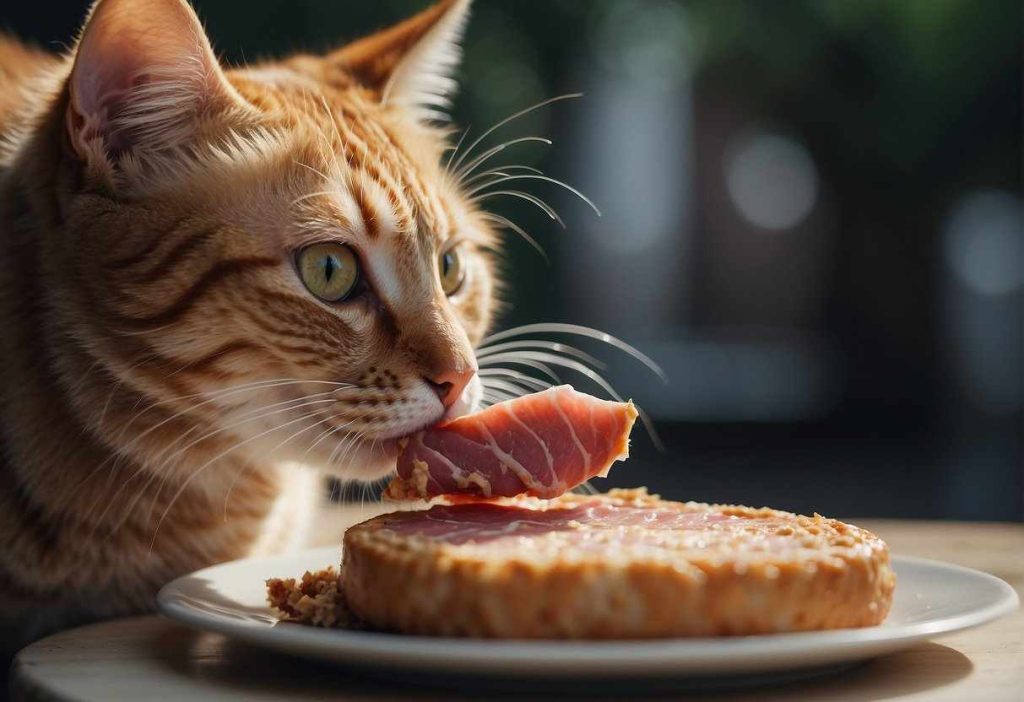
Navigating the world of your cat’s nutrition can feel like a tricky maze, but let’s explore some of the most common questions about feeding your feline friend raw meat.
Here, we’ll cut straight to the chase so you can feel confident about your choices.
Can all cats safely eat raw meat?
You might be eager to mimic your cat’s ancestral diet, but not all kitties may handle raw meat well.
Young, elderly, or immunocompromised cats could be more at risk for complications due to potential bacteria in raw meat.
How do I ensure the raw meat is safe for my cat?
Safety first! To minimize bacteria like salmonella and E. coli, source high-quality meat, store it properly, and keep it clean.
Consider consulting a vet who’s supportive of raw feeding for the best practices.
What are the signs that my cat is thriving on a raw meat diet?
You know your cat is living their best life when they show a shiny coat, good dental health, high energy levels, and consistent bowel movements.
These are telltale signs that the raw diet suits your kitty.
Are there any long-term risks associated with feeding raw meat to cats?
While some cats may reap benefits, others could face nutrient imbalances or bacterial infections in the long run.
Regular vet check-ups are crucial to monitor your pet’s health over time.
How can I balance my cat’s diet if I choose to feed raw meat?
Balance is key. A raw diet should provide all essential nutrients, so it often needs to be supplemented.
Bone meal for calcium and taurine for heart health are just a couple of examples.
Is a raw meat diet more beneficial than commercial cat food?
The jury’s still out on this one. Some say raw meat provides a diet closer to what cats would naturally eat, possibly leading to better health.
Nonetheless, high-quality commercial foods are formulated to meet all of your cat’s nutritional needs too.
Can I mix raw meat with other types of cat food?
Yes, you can mix it up, as long as you’re mindful of your cat’s overall nutritional intake.
Overfeeding, even with the good stuff, can lead to obesity or other health issues, so keep a balanced approach.
- Online Gambling Establishments Accepting Paypal: A Comprehensive Overview for Gamblers - July 26, 2025
- Leading Mobile Casino Sites: The Ultimate Overview for Online Gambling on the move - July 25, 2025
- Gambling Establishments That Approve PayPal: A Safe and Convenient Choice for Online Gaming - July 25, 2025

